

Ospedale di Santa Maria della Misericordia (13th century)
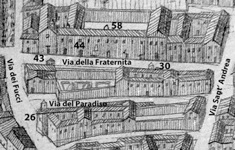
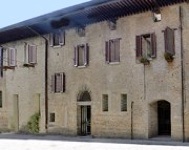
Ospedale di Santa Maria della Misericordia [58]
Details from the plan (ca. 1675) of Città di Castello
by Filippo Titi (Biblioteca Comunale “Giosue Carducci”)
This hospice, which cared for abandoned babies, was also known as the Ospedale della Fraternita, presumably because it was operated by a lay confraternity. The Commune took over its administration in 1294. It absorbed other nearby institutions in 1412 and again in 1513. It closed in 1773, when its function was taken over by the Ospedali Uniti (below). The complex has recently been adapted for residential use.
Ospedale di San Florido (1513)
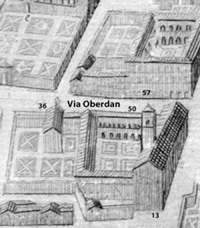
Ospedale di San Florido [57]
Details from the plan (ca. 1675) of Città di Castello
by Filippo Titi (Biblioteca Comunale “Giosue Carducci”)
This hospital was formed by the unification of a number of hospitals in the city in 1513, and was dependent on the Cathedral Chapter. It absorbed the canons’ earlier hospice next to the Chiesa di Spirito Santo. Its original building was restored and greatly extended in 1773, on the formation of the Ospedali Uniti (below).
Ospedali Uniti (1773-85)
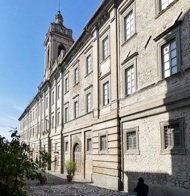
In 1773, the papal governor, Luigi Gazzoli unified the Ospedale di Santa Maria della Misericordia and the Ospedale di San Florido (above), having received the permission of Pope Clement XIV in the previous year. The premises of the latter were restored and extended over the period 1773-85 in order to house the new institution. It absorbed the functions and patrimonies of a number of other charitable institutions: Pope Pius VI sanctioned the last of these transactions, which involved the Ospedale di Pietralunga, in 1780. This complex functioned as the city hospital until 2000.
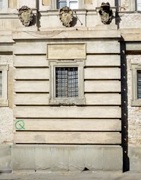
-
✴SS Floridus and Amantius;
-
✴the Commune; and
-
✴Monsignor Gazzoli.
The inscription below them records the completion of the work in 1785.
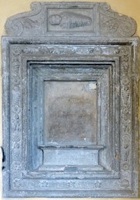
The Chiesa di Santa Maria della Carità [50], which had belonged to the friars of San Domenico until 1424 and then to the Confraternita della Carità, was demolished in 1832 to make way for the piazza in front of the hospital.
Art from the Complex
Processional Standard (16th century)
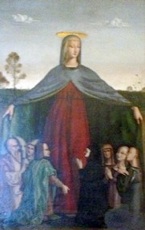
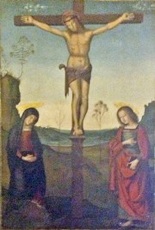
This double-sided standard, which is by an unknown artist and which belonged to the Confraternita della Carità, was first documented during its restoration in 1832. It was moved to the Pinacoteca Comunale in ca. 1878. Its respective sides depict:
-
✴the Madonna della Misericordia; and
-
✴the crucifixion with the Virgin and St John the Evangelist.
Laying on of hands (16th century)
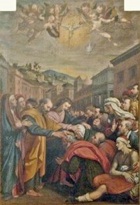
The altarpiece depicts SS Peter and John the Evangelist curing people by the laying on of hands, as the Holy Spirit descends in the form of a dove. The three crosses of the Crucifixion can be seen against the sky to the left, and the miracles are witnessed by the Virgin and two of her ladies (to the left).
Return to Monuments of Città di Castello.
Return to Walk I (Ospedali di San Florido; Ospedali Uniti) or
Walk II (Ospedale di Santa Maria della Misericordia).

